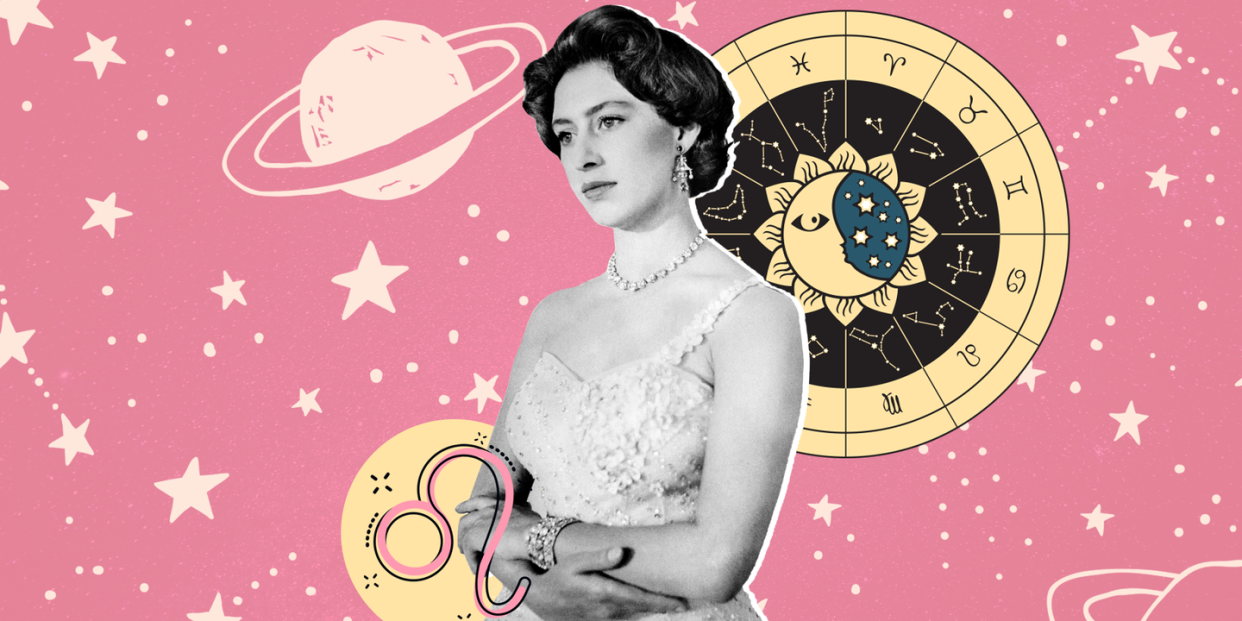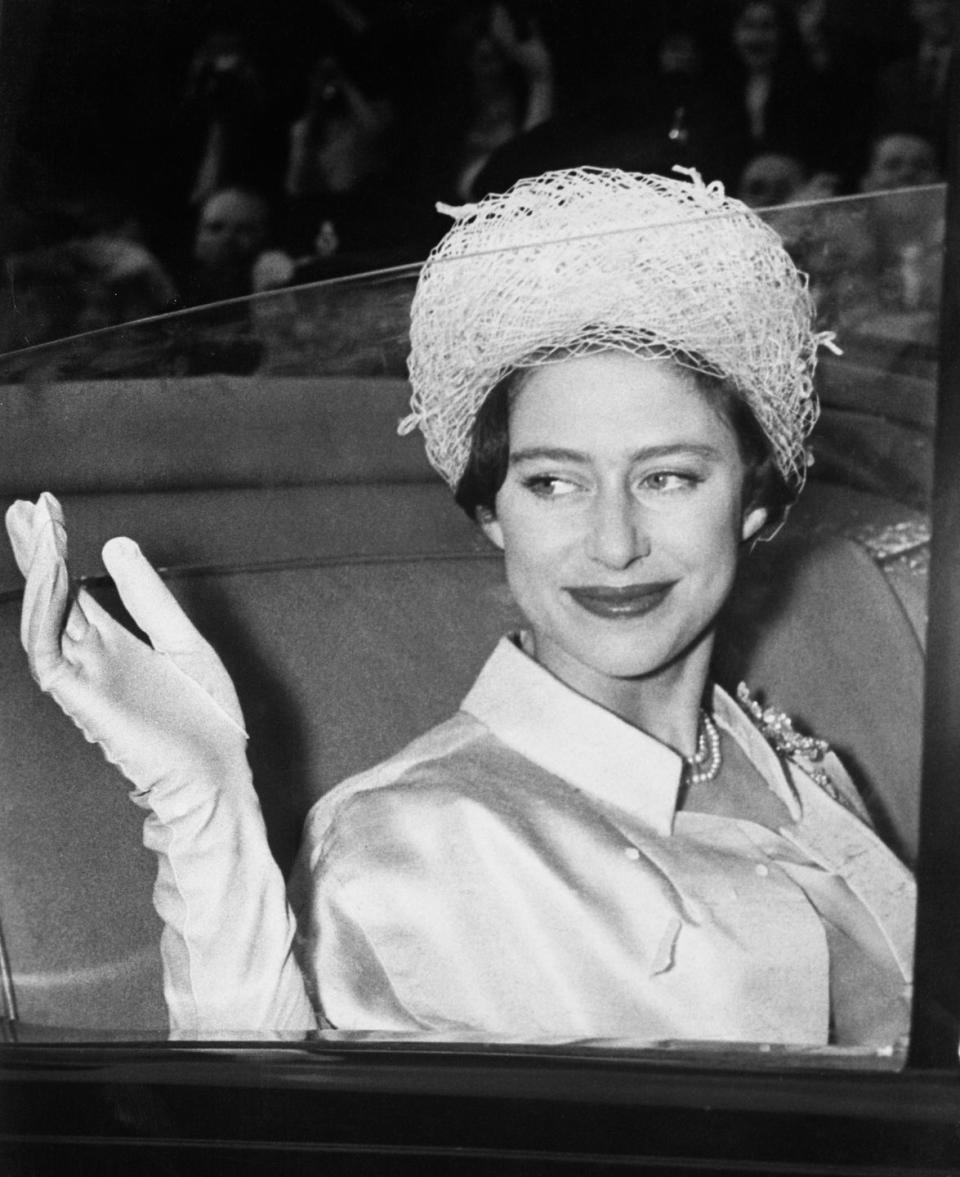Why Doesn't "The Crown" Show How Princess Margaret Helped Create Modern Astrology?

With the release of season 3 of The Crown, we're looking back at a surprising historical connection: The birth of Princess Margaret in 1930 and the way she helped create the modern horoscope system.
According to the CEO of Co-Star, one third of American adults read their daily horoscope. Here's why we can thank Princess Margaret for that.
Quick: Guess the zodiac sign of Princess Margaret, Queen Elizabeth’s chain-smoking dilettante of a younger sister. Born on August 21, Princess Margaret was a quintessential Leo—but she was also cursed with a Leo’s worst nightmare. Though Margaret craved attention and spotlight, she was forced to take a backseat to her more subdued (yet more essential) older sister, Queen Elizabeth, a storyline that's front and center in Season 3 of Netflix's The Crown.
As it happens, the fact that we're so familiar with Princess Margaret's sun sign in the first place is thanks to the royal herself. In fact, there wouldn't even be a modern horoscope system based on sun signs without the birth of Princess Margaret. (Now that's a sentence that would warm an attention-loving Leo's heart.)
Three days after Princess Margaret was born, astrologer R.H. Naylor predicted that she would have an “eventful life” in a column called "What the Stars Foretell for the New Princess," published by the Sunday Express on August 24, 1930. "Everybody is interested in the future. Can it be told by the stars?" the column began, introducing readers to a novel concept: The horoscope.
Naylor's influential column came about after John Gordon, the Sunday Express' editor, was stumped about how to cover yet another royal birth. Initially, Gordon reached out to Cheiro (real name: William John Warner), a famous astrologer who had previously told the fortunes of public figures like Oscar Wilde, Thomas Edison, and Margaret's uncle Edward VIII. In a fateful twist, Cheiro wasn't available for the column—but his assistant, R.H. Naylor, was.
To be fair, Naylor’s first proclamation about the newly-born princess's "eventful life" rings less like divination, more like fact: Margaret was born a princess in a castle, after all, an inherently eventful start to a life. Beyond that underwhelming statement, however, Naylor's first column exhibited some undeniable (and slightly spooky) prescience.
First, Naylor guessed that Margaret would grow up to show a "scorn of restraint"—which might explain why she's depicted kissing President Lyndon B. Johnson in The Crown. But most shockingly, Naylor also guessed that "events of tremendous importance to the Royal Family and the nation will come about near [Margaret's] seventh year.”
Naylor was a year off, but still impressively close to the event that would send the royal family reeling: In 1936, when the princess was just six, King Edward VIII abdicated the throne of England to marry Wallis Simpson, a divorced socialite. Margaret quickly went from being another privileged princess to being the younger sister of the future queen.

Was this a lucky guess—or was Naylor a pioneer in the medium of horoscopes? Depends on your thoughts about astrology. What is certain is that, with his Sunday Express column, Naylor was on his way to making the concept of "sun signs" a touchstone for people's identities.
The article about Princess Margaret's future was a smash hit with readers. Following that success, Naylor was hired by the Sunday Express to write two weekly columns: One predicting future world events, and one with predictions for that week's birthdays. A month later, he cemented his abilities as a mystic when he prophesied that "a British aircraft [would] be in danger between Oct. 8 and 15." Lo and behold, on October 5, an R101 airship crashed in France, killing 48 people.
With that, an iconic astrologer was born. Naylor began writing a weekly column in the Sunday Express called "Your Stars," an early version of the horoscope predictions based on your sun sign that millions of people now read daily, whether it's in the newspapers or apps like Co-Star, the most popular astrology app in the Apple store. Soon after Naylor, other newspapers were hiring astrologers of their own.
To modern day renowned astrologer Susan Miller, our culture's current surge of interest in astrology is evidence of a broader pattern in human behavior. "People have always loved astrology," she says. "Now, all these reporters are calling me asking why millennials are interested and why we're having a resurgence. But there's never never been a resurgence. We’re just talking about astrology now. That's all."
But long before the Internet, Naylor was faced with a challenge. Of course, he didn't have to time to generate 365 custom daily predictions to answer his 28,000 daily letters, the way he once did for Princess Margaret—so he set about devising a simplified system from an ancient practice. Craig Brown, Margaret's biographer, describes Naylor's process in his (excellent) book Ninety-Nine Glimpses of Princess Margaret: "He divided 360-degree transit into 12 zones, each of them spanning 30 degrees. He then named each of the 12 zones after a different celestial constellation, and offered blocks of predictions for each birth sign."
Translation: Naylor essentially created the personality profiles we now associate with our zodiac signs—12 archetypes associated with personality traits.
Technically, the subdivision of the zodiac into 12 signs has existed since way back in Ancient Greece and Babylonia—but Naylor's application of the signs for the newspaper-reading public was something new entirely. It's because of Naylor that we've come to immediately know what someone's sun sign typically says about them. And that's how Princess Margaret became a Leo.
By 1937, Naylor had fully incorporated the 12 sun signs into his weekly "Your Stars" column. Though Naylor stopped writing his column in the mid-40s, his simplified star sign-based horoscope system is still shining on to this day in the back pages of newspapers, the front pages of websites, and cryptic notifications from Co-Star.
Miller emphasizes the crucial place of a sun sign within a person's chart. (For the uninitiated, your sun sign is the sign you typically know as your zodiac, but we also have a moon sign, rising sign, and sign in each of the eight planets, all of which lead to a unique astrological profile.) "The sun sign is so important. It gives you authority. The place you have the sun is where you shine in life." Miller recommends horoscope-lovers also read the horoscope for their rising sign for more accuracy.
Even with the Internet, the creation of these predictions is far from simple. Miller writes about 40,000 words a month in astrology predictions, but the brevity required for the daily horoscopes poses a specific challenge.
“You need good discipline. You have to say things in a fresh way. I'm constantly stretching to use new words," Miller says.
Today, the internet is flooded with these brief predictions, which vary from site to site—just like the newspapers in Naylor's day. "Many astrologers like myself are very worried about this," Miller says about the increase in horoscopes. "So many people are pouring into the Internet and setting up an astrology site. I had to study for 12 years before I read a chart outside of my family!"
So how can a believer best navigate the stars? Miller recommends first identifying an astrologer who resonates with you, then checking up on their publishing history, past columns, and accreditation—though she concedes there are good astrologers who aren't accredited.
Ultimately, though, the kind of horoscope snippets Naylor popularized thanks to Princess Margaret in 1930 are not as in-depth as the other types of readings. "A sun sign horoscope can only get you so far," agrees Sweetman. "You really need the full birth chart, which is created from your birth date, birth place, and exact birth time. This is something that shows your full portrait, a map that you came into this life time with."
Miller adds: "You know how they always say less is more? Not in astrology. With astrology, short is confusing and misleading."
And that, readers, is how Princess Margaret changed astrological history forever. Now, we just have a friendly suggestion for Netflix: Might we suggest this important piece of zodiac history be incorporated into a future season of The Crown via flashback?
For more stories like this, sign up for our newsletter.

